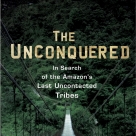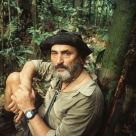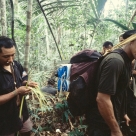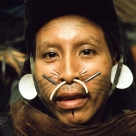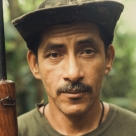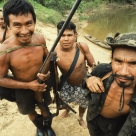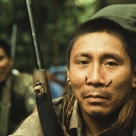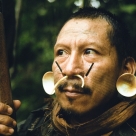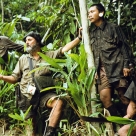Excerpt from The Unconquered: In Search of the Amazon’s Last Uncontacted Tribe
Author Scott Wallace joins a 34-man expedition led by jungle explorer Sydney Possuelo into the deepest recesses of the Amazon. The mission: to track one of the planet's most isolated and dangerous indigenous tribes, the mysterious "Arrow People." Almost nothing is known about the tribespeople, other than their reputation as deft archers who defend their lands with showers of deadly arrows before melting back into the forest shadows. The team will gather crucial information about the Arrow People, and return to civilization without contacting with the group. At least, that’s the plan. As head of Brazil's Department of Isolated Indians within its Indian affairs agency, FUNAI, Possuelo once drew on an entire bag of tricks to make contact with remote tribes. Now he uses those same techniques to shield the last remaining uncontacted tribes from the ravages of the encroaching frontier. Still, he must enter their world – one of permanent twilight beneath the jungle canopy – to get the information he needs to protect them. The stage is set for a strange and dangerous dance: to seek out the hostile tribesmen on the one hand, while trying to avoid them on the other.
Much like Lewis and Clark’s exploration of North America 200 hundred years earlier, the 34-man team includes indigenous scouts from three friendly tribes – Matis, Kanamari, and Marubo – who serve as guides and possible intermediaries in the event of an inadvertent contact with the Arrow People. The team hacks its way into virgin jungle, the chance of a possible encounter with hostile natives mounting with every step.
Midway through the afternoon, the sun broke through the clouds. Golden rays streamed through the foliage in a dazzling kaleidoscope of greens and yellows dancing on the forest floor. Soldado led the way through a tangle of head- grabbing vines, slashing away at the thicket. We emerged into a clearing commanded by a huge envira tree. Long strips of its shaggy bark had been peeled away from the trunk. A hole had been scooped in the ground at the base of the tree.
“Índios bravos – wild Indians,” Soldado pronounced gravely, his sunken eyes studying the forest beyond. “They’ve been here.”
We tromped through what appeared to be an abandoned banana grove, the low trees set in a patch of wild elephant grass slouched under the weight of their large, drooping leaves. Several had been slashed repeatedly at the base with what must have been a very dull ax.
“Capoera,” said Soldado, looking around. A fallow garden. Ivan Arapá picked his way ahead of us beyond the clearing, suddenly crying out in a loud whisper: “Pegada!” A footprint was pressed into the mud. It was so well formed that you could distinguish individual toes. Still, it was old enough—from the day before yesterday, Ivan calculated—to presume a minimum margin of safety between us and whoever had left it. The men now fanned out in all directions, like a search party scouring the woods for a lost child, scuffing up leaves, looking for clues.
For nearly three weeks, we’d been bushwhacking through primeval forest to reach one of the most remote places on Earth, which made Soldado’s next find all the more astonishing: a well- worn footpath snaking its way back through the forest. Unlike the nearly invisible path Possuelo had pointed out days before, this was as plain as day, the Appalachian Trail.
We burst through dense thicket into a sunlit clearing to behold a dozen low-lying palm-roofed huts. It looked like a temporary hunting camp, probably from the previous year. “Indigenous groups don’t always travel in large groups,” Possuelo said. “Sometimes just a family comes out—a man, a woman, three kids, a brother-in-law—maybe six or seven people. They might stay here a week or so, then move on.” I knelt down on hands and knees for a look inside one of the shelters. They were low to the ground, like pup tents, more suited for Hobbits than for full-grown human beings.
At the edge of the clearing, a pair of V-shaped jawbones sat in a cleft of a low tree. The bones were covered in a fine green moss, but the molars sat intact in their sockets, white as ivory. The front teeth were set at a sharp protruding angle from the bone, like those in a donkey’s snout.
“Anta,” said Ivan Arapá. Tapir. He moved in for a closer inspection. Why the tapir jaws had been left this way, nestled in the crotch of a tree, was anyone’s guess. Maybe some kind of totem, Possuelo surmised.
On the other side of the huts, Tepi and Binã Matis discovered a large ceramic pot buried in a mound of dried leaves. They hoistedit up for all to see. It was perfectly round, blackened with soot, large enough to hold a half gallon. Its walls were expertly shaped, uniformly thin; no casually thrown piece of clay. “This is the fi rst time I see one of their panelas,” said Possuelo. He took it in both his hands. “Heavy,” he said. “Difficult to carry.” It raised new questions about the Arrow People, attesting perhaps to a more sedentary existence than we’d imagined. Were the flecheiros the simple hunter- gatherers, unchanged since Vespucci, that Possuelo had earlier suggested? Or had they rather descended from a more striated agrarian society—shattered and uprooted like the Marubo who had fled into the far corners of the rainforest? Thus hidden away in this jungle citadel, had they since reclaimed a measure of stability, marking a return to a more settled existence, the fruit perhaps of Possuelo’s own work to protect them?
And another promising sign: the apparent absence of booby traps. Isolated tribes under pressure from intruders often littered jungle trails with spiked pitfalls, concealed beneath thin layers of leaves and branches. To guard against nasty foot injuries, FUNAI personnel working in places like Rondônia, where scattered indigenous groups were under constant harassment, lined their boots with PVC inserts. Here, the only punji- like sticks we’d encountered were those left by our own trailblazers as they swiped at saplings to clear our way forward.
We picked up the trail again where it led away through a pair of high trees. Not far beyond them, we came upon a chunk of masticated sugarcane lying on the ground. Nearby lay several clumps of white fiber—possibly cotton, possibly the lining from the pod of a kapok tree.
“Zarabatana! Zarabatana!” the Matis blurted excitedly. A blowgun. The tufts served as wadding to pack a dart in a blowgun’s chamber, Tepi explained. This was how we came to discover that the flecheiros in fact had other weapons—not only arrows—in their arsenal.
“Where are the others?” demanded Possuelo in a shouted whisper.
“Farther back,” the Matis said in unison, pointing over their shoulders.
“They need to catch up,” Possuelo groused. “Everyone has to stick together now.”
A short way farther on, a piece of coiled vine lay at the foot of a tree. It was a simple contrivance, used by forest people to bind their ankles together to shimmy into the treetops. The tree bore shallow indentations, where the strap had pressed into its soft bark. Just a few steps ahead, we found fresh footprints in the mud. “This is from agora,” Soldado said. “From right now!”
Possuelo read the skid marks and said: “He climbed the tree, saw us, came down, and took off running.” We moved forward in silence. Possuelo turned back and whispered: “Maintain visual contact with the man ahead of you at all times. Pass the word back!” Just in front of Possuelo, Soldado signaled with his machete ahead and to the right, toward a gap in high elephant grass that opened toward the river. “I saw something, over there!” he murmured. “Like a shadow moving!” We stopped, cocked our ears. Possuelo took a tentative step forward, cupped his hands to his mouth, and called out: “Whoooa! Whoooa!” Only the forlorn cry of the screaming piha replied.
We followed the path another twenty strides—then Possuelo hissed: “Turn off here!” He instructed Txema to leave a “Turn Right” signal for the others to follow—a bunch of snapped- off saplings that would make clear which direction we’d taken. Within five minutes we arrived at the banks of an igarapé some fi fty feet across. A tree spanned the channel, most of its trunk submerged just inches beneath the surface. Using a succession of long poles passed back and forth for balance, we crossed along the log, the swift current rushing over the tops of our boots, pulling on our ankles.
We plopped down on matted brush atop the bank, basking in the late- afternoon sun. A dazzling blizzard of butterfl ies—yellow, brown, and orange—danced all around us. It seemed as if we’d entered a land of magic. But Possuelo’s face had gone dark. “They know we’re here now,” he said. “No question about it.” For the first time since the expedition began, he strapped on his revolver.
***
The Matis led the way forward. Suddenly they pulled up in their tracks and pointed ahead, toward a cluster of trees beyond the sawgrass. Possuelo raised his hand for silence.
From off in the distance came a muffled, excited babble, unintelligible but unmistakably human. With hushed commands, Possuelo called for the Kanamari to come to the front of the column. Word was relayed back into the thicket, and soon Márcio and Remi appeared. “Call to them in Kanamari,” Possuelo instructed. “Tell them we’re friends, and we mean no harm.” The Indians cupped their hands and shouted toward the tree line. We strained our ears to listen. The distant murmuring ceased. Possuelo signaled the Matis to follow suit. They called out, but there was no response. Finally the Marubo took a turn. Again, nothing but the cry of the screaming piha.
Suddenly, without command and without explanation, our ranks broke. Everyone lurched forward, trouncing through the high grass in hot pursuit. In the excitement to catch a glimpse of the wild Indians, all discipline and sense of reason fell away. The sunlight danced like liquid gold on the river as we ran, ricocheting sideways in blinding flashes through the silhouettes of trunks and branches. Soldado and Paulo Welker cut left and made straight for the river, some two hundred yards off to the left. Possuelo held straight to the parallel course. I was torn: Whom to follow? In a split second, I decided to follow Possuelo. Bad choice. Within moments, we heard shouts behind us, coming from the direction of the water. It was Paulo Welker. “Over here!” he yelled. “Over here, they’re crossing the river!”
Soldado and Paulo Welker were heaving deeply, hands on their knees, by the time we reached the bluff above the river. Behind them rose the upended roots of an enormous tree that had fallen into the water. Another tree of similar dimensions had fallen from the opposite bank, some thirty yards distant, and the two trunks met halfway across the river to form a single span, in the shape of a shallow V, like a bridge that had taken a direct hit in the midsection and had collapsed into the water. Vines had been strung between the barren branches that protruded vertically from the prostrate logs to form a makeshift handrail. Clearly, this was a regular transit point for the flecheiros. “I saw one!” Welker gasped, still struggling to recover his breath. “He was naked, with long hair. Broad shoulders. Strong. He ran across the bridge. Disappeared into the woods.” He pointed across to the far side of the river.
“There were two of them,” corrected Soldado. “They were naked—but for a string tied around their waists.” As he had done before, Possuelo commanded the Indians to call out toward the high trees across the river. He cupped his hands and hooted, the Indians pleaded, but there was no response.
“Who’s carrying those small pots we brought along for gifts?” Possuelo called out. José, Soldado’s son-in-law, stepped forward. “Take three of those pots and shine them up nice,” Possuelo said. “String them here at the bridgehead. It will be our way of saying thank-you.” Soldado yanked a creeper from a nearby tree, then strung it through the handles of the cooking pots. He and José pulled the cord taut and tied off both ends to low-hanging branches. The pots dangled invitingly, about waist- high off the ground.
When it came to the business of giving gifts to “untamed” Indians, the presentation could be just as important as the presents themselves. Positioning them up off the ground made it clear that they were actual gifts, offerings of peace to their intended recipients, not merely discarded objects. It was also a sign of respect, a symbolic way to hand over the presents without physically doing so. For Possuelo, every gift he’d ever left at an attraction altar or on a remote jungle path was situated in a historical context that dated back to Portuguese navigator Pedro Cabral’s first encounter with native Brazilians in 1500.
“The act of giving gifts . . . is perhaps the most ancient means of demonstrating peaceful intentions, especially when peoples of different languages come face to face,” Possuelo wrote in his memo to FUNAI colleagues on the fundamentals of a successful attraction campaign. “Since that first contact in the Age of Discovery to this day, all that we’ve done has been a repetition, with variations imposed by time and circumstance, of Cabral’s initial gesture.”
The shiny aluminum pots left at the bridgehead offered a novel twist. The objective was simply to avoid attack, not to make contact—to show friendship, not to seduce the Indians into giving up their way of life. “Will it work?” I asked. “Hard to say,” Possuelo replied. “Many times they destroy the presents to demonstrate their rage at the white man.” The anger would hint at some previous atrocity perpetrated on the Indians, for which the FUNAI team bore no blame, other than the fact of being emissaries from the same outside world. Wooing natives from the bush took finesse, requiring sertanistas to decipher the varied responses to their overtures—and to adjust methods accordingly. Indians might take knives and machetes, for example, but refuse a sack of sugar, hinting at the possibility that ill-intentioned whites may have poisoned them with arsenic-laced sweets in the past. They might leave crude relics of axes or scissors carved in wood, to signal their desire for more of these commodities. Besides smashing gifts, Indians might show resolute repudiation by leaving behind a dead animal at the offering hut, perhaps even a monkey for its obvious resemblance to the human form, heart impaled with an arrow like a voodoo doll.
Once the pots were in place, Possuelo rose to his feet. He wanted to put distance between us and the Indians, as quickly as possible. “Embora!” he barked. “Let’s get moving!”
We followed the river, cutting in and out of the woods between patches of shadow and dazzling sunlight. We trudged across the sandy bed of an incoming creek through a swirling cloud of orange and yellow butterflies. We dashed up the banks and stumbled back into the forest twilight. We’d been on a fast march for a half hour when Possueloordered the column to halt at a bend in the river that looked down on a long white beach.
“The Arrow People have three malocas up ahead—there, there, and there,” he said, pointing across the river at scattered intervals to the north and northeast. “We could keep walking for hours and not get any farther away from them. We’d better just camp here.” He was certain the two Indians who’d crossed the bridge were shadowing us from the far side of the river, following our every move. They would soon head for their village, he was sure, to report every detail of what they’d seen. “Listen up!” he shouted for all to hear. “Everyone down to the beach, on the double! And bring your rifles!”
On the reconnaissance fl ight over the area prior to the expedition, Possuelo had made note of the locations of every clearing he’d observed and how many huts were in each. Extrapolating from the number of huts and their relative sizes, he figured each village to hold no more than fifty or sixty people. That made for seven or eight ablebodied men in any one settlement—probably too small a number for them to risk a strike. Of much greater concern was the chance that the Arrow People could mass forces from several outlying malocas for a more concerted and deadly assault. That would take more time, but the clock was already ticking. “There is nothing to keep them from setting up an ambush for us farther downriver,” he said. He hoped to preempt such notions right now, by showing the Indians what we had—in terms of men and weapons. Gaunt as scarecrows in our tattered fatigues, we stumbled out of the woods, the expeditionaries lugging their rifles. “Spread out down the beach,” commanded Possuelo. “Let them see that we are many.” We staggered along the shoreline, feet slipping in the loose sand. We turned to face the towering wall of trees on the opposite bank, no more than a hundred feet away. “Stand up straight, look strong! Hold your guns up high!” Possuelo ordered. “Let them see how well armed we are.”
Rifles came up off hips and shoulders, tilting toward the manila tufts of evening clouds that drifted overhead. Of course, Possuelo had no intention to turn our rifles on them. He’d sooner have died than fire upon the Arrow People. But he needed them to think that we might. It was an odd combination: gifts on the one hand, guns on the other. The carrot and the stick. We stared across the river into the trees beyond the far bank. We saw nothing but the high wall of jungle, but we could feel their eyes upon us. All we could hear was the incessant flow of the water and the rush of blood pounding in our ears.
* * *
Crown Publishing Group
© 2011 and 2012 by Scott Wallace
Exclusive for Drunken Boat
For nearly 30 years, Scott Wallace has covered armed conflict, international organized crime, and vanishing cultures for some of the world’s most prestigious media. Formerly a news correspondent for Newsweek, the Guardian, and CBS News in Central America, Scott is a frequent contributor to National Geographic and other publications. His writing has also appeared in Harper’s, Grand Street, Smithsonian, National Geographic Adventure, Condé Nast Traveler, Sports Afield, The Nation, and the Village Voice. His photography credits include National Geographic Traveler, Smithsonian, Outside, Details, and The New York Times. He has undertaken five assignments in the Amazon for National Geographic publications.

